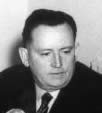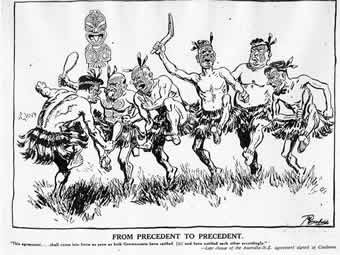 |
|||||||||
'From precedent to precedent' - Cartoon Interpretation: Teachers' Resource
This is a step by step resource for classroom teachers to use with senior school students, based on the concept of 'chunking' as a method of intepreting cartoons. Teachers should familiarise themselves with the 'chunking' process which is fully explained in the freely downloadable JCPML publication Cartoon PD in a Package before using this cartoon activity in the classroom.
Note: Student responses to the questions will vary according to their understanding of the symbols and captions in the cartoon. Due acknowledgement should be given to a range of answers where valid explanations, logically explained and justified are given.
Cartoon by Ted Scorfield published in the Bulletin, 2 February 1944.
Click on the cartoon below for a larger image to use with your class. Use the 'landscape' option when printing the cartoon.
FROM
PRECEDENT TO PRECEDENT.
"This agreement... shall come into force as soon as both Governments
have ratified [it] and have satisfied each other accordingly."
- Last clause of the Australia - N.Z. agreement signed at Canberra.
Context
- In 1931 the British Parliament passed the Statute of Westminster establishing Australia as an independent state, able to form its own foreign policy and defence, free from British control.
- Initially, Australia, unlike Canada and South Africa, made no attempt to ratify the five key sections of the Act which required separate Australian action.
- The decision of the Curtin Government to legislate for parliamentary ratification of the Statute of Westminster in the second half of 1942, was a major step forward in Australia’s preparedness to forge its own legal identity in the international arena. The first opportunity came in early 1944.
- Australia was angry that the Allies had met in December 1943 and, without consultation or the provision of much information, had decided on issues of importance to the Pacific region.
- These decisions included stripping Japan of all her conquests, restoring to China territories taken by Japan and restoring to European powers their former territories in the Pacific.
- New Zealand shared Australia’s concern about the lack of consultation but it was Australia that took the initiative by arranging a conference between the two nations and then put forward the suggestion of a treaty.
- Through the Australian-New Zealand Agreement of 1944, Australia and New Zealand unilaterally stated their right to share in discussions about the South-West and South pacific area.
- Under this agreement Australia and New Zealand agreed to consult and work together on matters such as: security and defence, post war disposal of territories and bases, and, the welfare of Pacific people.
- The Australian cabinet ratified the agreement on 24 January
1944 and New Zealand on
1 February. - This was the first time that Australia had entered into an international agreement to which Britain was not a party.
- The agreement was generally welcomed by the UK government and the British press. It received an unsympathetic hearing in the United States.
- The agreement can also be considered the forerunner of the ANZUS treaty signed between Australia, New Zealand and the United States in 1951.
Copy 1
| Highlight | Name of cartoonist |
| Source | |
| Date of publication |
The Cartoonist:
Born Northumberland, England, 1882, died Mosman, New South Wales 1965.
Edward Scafe Scorfield served in the Royal Engineers during World War
One, serving at Gallipoli, Salonika, Greece and Palestine. After the war,
he began drawing cartoons for the Newcastle Weekly
Chronicle before coming to Australia to work for the Bulletin
as a cartoonist and illustrator in 1925. His cartoons followed the Bulletin
line of the time, combining Australian nationalism and British conservatism.
In World War Two, Scorfield's cartoons 'lionised the Digger, exalted the
Allies against the Japanese, and lampooned black-marketeers, strikers
and white feather conchies.' Scorfield stayed with the Bulletin
until 1961.
Information from biography of Ted Scorfield by
Peter Coleman in the Australian Dictionary of Biography, Volume 16, pp
197-8
Publisher: The Bulletin described itself in the 1940s as 'The national Australian newspaper' with the rider 'Australia for the white man'. It was generally pro-private enterprise, anti-union and against any moves to socialise industry. The Bulletin's editorial of 2 February 1944 gave a comprehensive and favourable analysis of the Anzac Agreement, even though the accompanying cartoon looked at the treaty more light heartedly. In the war years the Bulletin was particularly supportive of the Australian fighting male, including a lot of humour about Aussi soldiers and the Australian way of life in its articles and cartoons.
Ask students about the information they can glean just from the introductory information, especially for questions about CONTEXT.
Copy 2
| Highlight | Maori carved pole |
| grass and bare feet |
What does the Maori carved pole represent?
(This is an artist’s image of the sort of carving that you see outside
Maori meeting houses – it is Scorfield’s way of representing
New Zealand in the cartoon.)
What is unusual about the grass and bare feet?
(This is a political cartoon in an unexpected setting. It is unusual to
see politicians in bare feet jumping about on grass. It adds an extra
dimension to the ‘precedent’ mentioned in the caption - the
cartoon situation is a 'precedent' also.)
Copy 3
| Highlight | the third character from the right |
Who does this character represent?
How does the cartoonist identify the character as an Australian?
Copy 4
| Highlight | all the other characters |
The following people attended the Australian-New Zealand conference of 1944 - use the photos to help identify as many of the cartoon characters as possible.

John Curtin, Prime Minister of Australia and Minister for Defence.
(image JCPML00036/13)

John Dedman, Minister for War Organisation of Industry.
(image JCPML00438/3)

Peter Fraser, Prime Minister of New Zealand. (image
JCPML00376/16)

Herbert Evatt, Attorney General and Minister for Foreign
Affairs, architect of the Anzac Agreement. (image JCPML00376/102)

Frank Forde, Deputy Prime Minister and Minister for the Army. (image JCPML00409/6)
(From left to right in the cartoon, the characters represent: Herbert Evatt, unidentified person, Peter Fraser, John Curtin, Frank Forde, and John Dedman.)
What do both the characters on the left hold in their
right hand?
(They have a mere or short club in their right hand. Short clubs were
originally used for face-to-face combat.)
In what other way do the two characters on the left
differ from those on the right?
(They are facing one another, carrying their meres with their tongues
stuck out, a war-like expression used in the Maori dance, the Haka.)
Which character in the cartoon seems to be the driving
force in the dance? Identify this character?
(The character on the left with his back facing the reader is Herbert
Evatt, the architect of this agreement, the driving force behind it. Note
that Scorfield has drawn him with a very powerful body, unlike the other
characters in the cartoon, perhaps to emphasise his importance.)
The character third from the left is making a 'V'
symbol with his fingers. What does this signify?
(Winston Churchill was the first wartime Allied leader to use the 'V for
Victory' sign. In this cartoon Peter Fraser is making the victory sign.
Perhaps the cartoonist is saying that this agreement is a victory of the
small powers over the large powers – remember that this agreement
was in response to decisions made by more powerful countries.)
What do you notice about the way the characters
are dressed?
(The characters are all wearing flax skirts (piupiu) and have full face
tattoos (moko)).
Copy 5
| Highlight | caption 'FROM PRECEDENT TO PRECEDENT' |
To what does the caption 'FROM PRECEDENT TO PRECEDENT'
refer?
(The first precedent for the Australian Government was the late 1941call
to America for assistance with the war against Japan. The Australian-New
Zealand Agreement of 1944 was another precedent. It was the first international
treaty Australia had signed on its own.)
What does the cartoonist suggest the two countries
will do to show that they have ratified the agreement?
(Australia and New Zealand will have a traditional haka to celebrate the
signing of the agreement and show the world the face of these two ‘warrior
nations’.)
What makes this cartoon funny?
(Depicting dancing barefoot politicians as warriors in flax skirts and
face tattoos makes them look ridiculous. The cartoonist wonders who this
agreement will actually affect? The idea that an agreement between two
small powers will ‘frighten’ more powerful countries is a
bit of a laugh. He is poking fun at Australia and New Zealand pretending
to be great warrior nations in the tradition of the Maori warrior.)
At the completion of this process, you may wish students to answer written questions on the cartoon which you can tailor to reflect the teaching points you wish them to cover.

